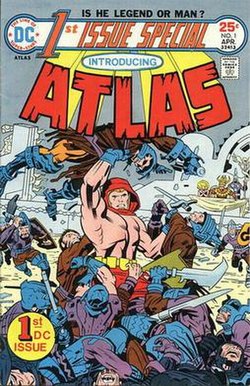Publication history
Writer Gerry Conway explained the series' origin: "1st Issue Special was a peculiar book concept based on [publisher] Carmine Infantino's observation that first issues of titles often sold better than subsequent issues. Carmine's brainstorm: a monthly series of nothing but first issues. It sounds like a joke, but he was dead serious." [2]
Conway has also denied that 1st Issue Special was a tryout series, pointing out that tryout series run each feature for several issues so that the publisher has enough time to get sales figures before deciding whether to give the feature its own series; since each feature in 1st Issue Special ran only one issue, DC would have had to either launch the new series before sales figures came in for the tryout (thus making the feature's appearance in 1st Issue Special pointless) or launch the new series six months or more after the tryout issue (by which time reader interest in the feature would have faded). [3] Conway added, "We used to sit at editorial meetings and [Carmine Infantino] would say, 'Who has an idea for 1st Issue Special next month?' How do you develop a project that has a potential to be a real series within 20 days? You can't." [3] Only two of the 1st Issue Special features received an ongoing series: Mike Grell's The Warlord, which first appeared in issue #8 (November 1975), [4] and Gerry Conway and Mike Vosburg's Return of the New Gods, which appeared in issue #13. [2]
Issues #1 (featuring Atlas) featured art and story by Jack Kirby. [5] A number of issues featured existing DC characters: issue #3, Metamorpho, issue #5, Manhunter, [6] issue #7, the Creeper, issue #9, the Golden Age character Doctor Fate, and issue #13, the New Gods. [3] The Metamorpho feature reunited the character's creators, writer Bob Haney and artist Ramona Fradon. Haney and Fradon had met at the 1974 San Diego Comic-Con, and while reminiscing, it emerged that both of them regarded Metamorpho as one of the features they had most enjoyed working on, leading them to ask DC if they could do one more Metamorpho story together. [3] 1st Issue Special staff have not been able to answer why the Creeper story was illustrated but not written by the character's creator, Steve Ditko. [3]
Issue #12 featured a new Starman character which would later be used in James Robinson's 1990s series focused on the character Jack Knight. [3] The character was a supporting player in Justice League: Cry for Justice in 2010.
Some stories which had been intended for publication in 1st Issue Special appeared in other titles instead. A Batgirl and Robin team-up was published in Batman Family #1 (September - October 1975) [3] and a Green Arrow and Black Canary story was kept in inventory until it was published as a backup feature in Green Lantern #100 (January 1978). [7]
1st Issue Special never included a letters column, instead accompanying each feature with a "Story Behind the Story" text page. [3]
DC published a hard cover collection of the series in 2020. [8]
Characters from 1st Issue Special star in the 12-issue 2022-2023 DC Black Label series Danger Street by Tom King and Jorge Fornes. [9] Instead of devoting separate issues to each character or group, as in the original series, Danger Street incorporates all the different characters into overlapping narratives. [10]
This page is based on this
Wikipedia article Text is available under the
CC BY-SA 4.0 license; additional terms may apply.
Images, videos and audio are available under their respective licenses.
